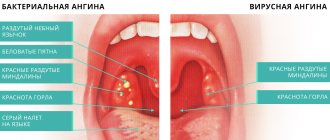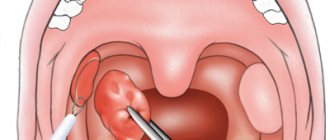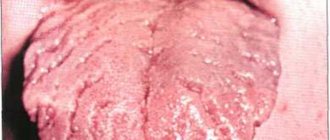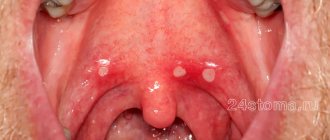Symptoms of sore throat in an adult, causes and treatment
Sore throat in adults does not always occur in its true form. Often, with any sore throat, patients diagnose themselves on their own and most often call it a sore throat, without trying to understand the true diagnosis.
Sore throat is most often confused with laryngitis, pharyngitis, and the common cold. In order to avoid such misconceptions, you need to know what the signs of sore throat are in adults and how it progresses. Even if these signs are present, it is necessary to consult a doctor to receive adequate treatment.
The disease is mainly caused by staphylococci, less commonly pneumococci or a combined type of infection. Bacteria and viruses come both from the outside and pathogens already present inside the body are activated. They usually live in carious teeth, nasopharynx, and maxillary sinuses. Their activation is facilitated by any weakening of the immune system: hypothermia, stress, colds, prolonged exposure to various allergens, contact with a sick person.
Causes
The most typical infectious agents include staphylococci, streptococci, pneumococci, some representatives of the diplococcus genus and enteroviruses.
Routes of infection:
- Endogenous (in patients suffering from gastroenteritis, purulent sinusitis, chronic tonsillitis and caries).
- Airborne (the most typical route of transmission).
- Enteral (together with contaminated dairy products).
- Hematogenous (with blood flow from organs and tissues infected with the pathogen).
- Artificial (during surgical operations on the nasopharynx and nasal cavity).
Most often, angina affects people who have reduced sensitization and reactivity of the body, or have congenital immaturity of physiological systems, or have chronic pathological processes in the ENT organs. At the same time, the condition of the tonsils and the virulence of the microflora play an important role in the development of the disease.
Causes
In 70-80% of cases, the causative agent is group A β-hemolytic streptococcus (GABHS). In addition, the pathogens can be other types of streptococci, staphylococci, influenza bacillus, Klebsiella, mycoplasma, chlamydia, etc. Sources of infection are patients and carriers of pathogenic microbes. Most often, infection occurs through airborne droplets (through the air) or nutritional routes (through hygiene items, dishes, etc.). There is a seasonality of sore throats - outbreaks of morbidity occur in the winter-spring period. Sore throat most often occurs within 1-2 days from the moment of infection.
In the development of tonsillitis, a certain role may be played by the body’s reduced adaptive ability to cold, sharp seasonal fluctuations in environmental conditions (temperature, humidity, nutrition, intake of vitamins, etc.), trauma to the tonsils, constitutional predisposition to tonsillitis, the state of the central and autonomic nervous system . Factors predisposing to angina are chronic inflammatory processes in the mouth, nose and paranasal sinuses.
Classification
There are several forms of the disease:
- Catarrhal sore throat. It usually develops very quickly. The main symptoms are malaise, dryness and sore throat. Next, swelling of the pharynx appears, pain when swallowing and in the lymph nodes. This type of sore throat is characterized by an increase in body temperature to 39°C, the appearance of chills, body aches and severe migraines. After 3-5 days, the main symptoms of the disease disappear or change into another form - it all depends on the treatment.
- Lacunar tonsillitis. The first symptom is a sharp rise in temperature (up to 40 degrees). There are also sensations of pain in the larynx, muscles, joints, and heart. Saliva production increases significantly. Children may experience vomiting due to intoxication. With this form, fluid accumulates in the lacunae (fibrinous exudate). The mucous surface of the pharynx and tonsils turns red, swells, yellowish islands appear, the tonsils become covered with a whitish coating, which is easily cleaned off with a medical spatula. There is swelling of the cervical lymph nodes and pain in their locations. This type of sore throat lasts for a period of time of 5 - 7 days. A slight fever can also be observed after the acute period.
- Follicular tonsillitis, unlike catarrhal tonsillitis, develops slowly, but is no less painful. Its danger lies in its complications: when your headache gets worse, your body temperature rises, your joints ache, you need to see a doctor for a diagnosis and recommendations for treatment. With this type of sore throat, the lymph nodes under the jaw become very painful and become enlarged. It should be treated in a hospital setting.
- Necrotizing tonsillitis occurs with more severe symptoms than lacunar and follicular tonsillitis. It is accompanied by high fever, nausea, and vomiting. Blood tests for necrotizing tonsillitis show pronounced leukocytosis and neutrophilia. Tonsils with this sore throat are covered with a yellow-green coating, less often - gray. Often, when removing plaque, the mucous membrane bleeds, since tissue rejection occurs at the site of infection under the influence of fibrin. This rejection can spread not only to the tonsils, but also to the surrounding areas - the arches, the uvula, the back wall of the pharynx.
Sometimes forms of tonsillitis can be combined, which makes treatment much more difficult. On one tonsil there may be lacunar, and on the other - follicular tonsillitis.
Classification of forms of tonsillitis (tonsillitis)
- I catarrhal form (the inflammatory process is manifested by redness and swelling of the tonsils).
- II follicular form (yellowish purulent dots appear on the surface of the tonsils - festering follicles).
- III lacunar form (liquid pus or purulent-caseous plugs form in the lacunae).
- IV fibrinous form (characterized by the formation of a single continuous plaque of a whitish-yellow color, which can extend beyond the tonsils, often occurs in people with reduced immune system function).
- AIDS, blood diseases, hunger, old age.
- V herpetic form (most often caused by adenoviruses, herpes simplex viruses, characterized by vesicular rashes on the back of the pharynx or soft palate, predisposed to ulceration).
- VI phlegmonous form (intratonsillar abscess) is a complication of acute tonsillitis (lacunary, catarrhal, follicular) or chronic tonsillitis, which is an acute purulent inflammation of the peritonsillar tissue.
- VII ulcerative-necrotic form (gangrenous form) - characterized by the formation of yellow-white blisters (ulcers) on the tonsils, in some cases the spots spread to the entire oral cavity and throat.
- VIII mixed forms (a variant of the disease in which colonization of lymphoid tissue occurs by several pathogens at once, as a result of the addition of a secondary infection or with a severe decrease in immunity).
General symptoms of sore throat
With the development of angina, the main symptoms in an adult appear depending on the severity of the clinical picture. The acute form of the disease is characterized by rapid development.
The first signs appear:
- hyperthermia (high temperature), impaired swallowing functions;
- enlargement and inflammation of the tonsils (glands), possible pustular lesions;
- sudden syndrome of acute sore throat, gradual increase in pain;
- hypertrophy and inflammation of the lymph nodes in the submandibular zone.
In the subacute form, the disease is sluggish. Mild symptoms appear and vary in duration from 1 to 3 months. Both adults and children experience:
- changes in the intensity of pain;
- halitosis (not a fresh mouth odor);
- slight hypertrophy (enlargement) of the tonsils;
- foul-smelling viscous discharge from the tonsillar niches;
- change in taste.
The chronic form usually develops in patients who regularly tried to independently treat a sore throat at home, who suffered the disease “on their feet”, without bringing the treatment to complete recovery. Symptoms are periodic - they appear and then disappear. Noted:
- mild swelling of the lymph nodes;
- slight signs of redness of the tonsils, their slight enlargement;
- periodic manifestation of pain symptoms in the throat.
The symptoms of the disease in adult patients and children are the same, since due to its contagiousness, one sick family member can infect all household members, including children.
Diagnosis of sore throat
The success of treatment will depend on timely and competent diagnosis. The first stage of the examination is to examine the condition of the patient’s pharynx, during which the attending physician will assess the main signs of the disease: the degree of enlargement of the tonsils and the presence or absence of purulent plaque. It is also necessary to assess the degree of enlargement of the lymph nodes in the ears, neck and back of the head.
Taking blood tests will determine the degree of increase in leukocytes and ESR, characteristic of bacterial tonsillitis. With viral sore throat, the leukocyte level remains within normal limits or decreases slightly, and the erythrocyte sedimentation rate increases slightly.
To determine the causative agent of the disease, cultures of mucus from the oropharynx are examined in laboratory conditions. This is important for determining the class of the disease and competently prescribing medications for the treatment of sore throat. For complicated or particularly acute symptoms, the attending physician may prescribe an ultrasound of the neck.
What are the symptoms of purulent tonsillitis?
With a sore throat, a person becomes weak, the body temperature rises to 40 degrees, it is impossible to swallow, severe pain in the throat occurs, a headache occurs, and the throat becomes very red. When the doctor examines the throat, he notices that the tonsils are enlarged and covered with plaque on top, often causing pain in the joints. If the disease is treated in time, the person becomes better after 5 days. Doctors often diagnose acute respiratory infections instead of a sore throat, but remember, if the temperature is above 39 degrees, this means that the throat is severely inflamed. At the same time, the patient cannot drink, eat, has difficulty speaking, and then begins to get tired quickly.
If the sore throat is purulent, the lymph nodes become significantly enlarged, the tonsils located on the soft palate change, and ulcers begin to appear on them.
How long does the temperature last for a sore throat?
Sore throat is a clear cause of increased body temperature. A distinctive feature of an acute infectious disease is a sharp rise in temperature that persists for a short time. Visible symptoms of a sore throat are sore throat, plaque on the tonsils, and general weakness. On average, high temperatures last up to 5 days. The duration of the disease depends on the nature of the sore throat:
- catarrhal - duration is 1-2 days;
- follicular - 3 - 4 days;
- lacunar - 4 - 5 days;
- herpes sore throat (herpangina) - 1-3 days;
- Simanovsky-Plaut-Vincent angina - 1 - 2 days or passes without fever.
Natural changes in indicators due to the individual characteristics of the body, especially immunity and general susceptibility to viruses, should be taken into account. Different types of sore throats have similar signs of the disease, differing in the location of purulent areas. The absence of temperature during tonsillitis indicates a decrease in the body’s protective functions and an inability to resist the disease on its own.
Types of sore throat
Sore throat differs in the degree of damage to the tonsils:
- catarrhal - the easiest option, in this case the inflammatory process affects only the mucous membrane, the tonsils are swollen and bright red
- lacunar – damage to the canals of the tonsils (lacuna), the tonsils are covered with a characteristic white coating;
- follicular - follicles are formed in the tonsils, which are filled with pus;
- combined - a severe form of tonsillitis, when both lacunae and follicles are affected on the tonsils.
How to treat a sore throat?
Below are a number of universal recommendations that must be followed when treating sore throat at home:
- Bed rest. Having a sore throat on your legs often leads to the development of complications.
- Drink plenty of fluids. It is necessary to relieve intoxication and remove pathogens and their waste products from the body. You can drink water, tea, compotes, fruit drinks, juices. The main thing is that they are warm.
- Antiseptics. All kinds of lozenges, lozenges and aerosols for sore throat are used in cases of severe pain as symptomatic therapy.
- Antipyretics. They are taken if the temperature has risen above 38 degrees and it becomes difficult for the patient to tolerate it.
- Gargling for sore throat. Helps get rid of white plaque, which is a source of inflammation. It is recommended to gargle every hour if you have a sore throat.
In most cases, sore throat is caused by streptococci, so the main medications for sore throat are penicillin antibiotics. The most effective of them is benzylpenicillin. If the patient is allergic to penicillins, then macrolides (Azithromycin, Erythromycin) may be prescribed. Tetracyclines and sulfonamides are ineffective for angina.
We have all encountered more than once the problem of treating a sore throat, especially in childhood. And each of us has memories left in our memory, like a fragment of a picture from a movie, a warm bed, tea with raspberries and an anxious mother who is watching you with pain in her heart, putting a cold towel to her forehead, trying to reduce the fever, because... Typically, such infectious and inflammatory diseases of the oral cavity are accompanied by high fever. So what causes a sore throat and how can you cope with the consequences of this disease so as not to provoke complications.
According to medical statistics, infectious and inflammatory diseases of the mouth and throat account for an average of 30% of the total number of diseases of the ENT organs. The main causative agents of this kind of throat infection are bacteria, the so-called pathogenic microorganisms staphylococci and streptococci, which can easily get on the mucous membrane of the throat and provoke inflammation, especially in children, who are traditionally included in the “risk group”. But in addition to pathogens of a bacterial nature, yeast-like fungi of the Candida albicans group and mold fungi of the genus Aspirgillius can also complicate the course of throat diseases, which are difficult to treat and require, first of all, diagnostic measures to identify the causative agent of the infection, both bacterial and infectious in nature, that provoked inflammation, and selection of a treatment regimen that can suppress two pathogens at the same time. And diseases such as pharyngomycosis and laryngomycosis are among the socially significant diseases, because require an individual approach to therapy.
Usually, the presence of an acceptable amount of opportunistic microorganisms produced on the mucous membranes of the nasopharynx, larynx and throat serves as a natural barrier against external infection entering the body, but as a result of exposure to external and internal factors, their volume may increase, and due to additional infection by bacteria and pathogenic microorganisms , diseases of an infectious and bacterial nature can develop, including those aggravated by a fungal infection, such as mycosis of the throat or candidiasis.
It should be noted that fungi of the genus Candida are quite widespread and, as a result, the possibility of getting this infection in public places through shared objects, food, including by airborne droplets is quite high. In addition, the development of this type of infection can be caused by such reasons as uncontrolled and long-term use of antibiotics without special indications, less often, disruption of hormonal levels and the endocrine system, reduced immunity, frequent diseases of a viral nature, childhood, incl. and incorrectly selected therapy for ENT diseases.
Fungal infections of the throat differ from the symptoms of ordinary sore throat of a bacterial nature in the appearance of plaque, which resembles cottage cheese. It is easy to remove, but underneath there is an inflamed mucous membrane, with redness and ulcers. And if a fungal throat infection is caused by fungi of the genus Aspirgillius, then such plaque is quite difficult to remove and has a yellowish tint. It should be noted that the localization of a fungal infection in the mouth and throat is also characterized by the manifestation of symptoms of a common sore throat.
It is quite difficult to detect fungus in the mouth and throat at an early stage, because... at the beginning of infection it usually does not appear, only as the colonies increase. Characteristic symptoms begin to appear gradually, in the form of discomfort, soreness, burning and dryness in the throat, and pain during swallowing. In addition, there is a presence of white plaque in the larynx, tonsils, tonsils and tongue, as well as the appearance of erosive surfaces in the form of ulcers and cracks in the mucous membrane of the throat. Traditionally, the temperature rises, headaches appear, swelling of the nasopharyngeal mucosa occurs, as well as characteristic symptoms of general poisoning and intoxication.
In children, the course of fungal tonsillitis is much more severe than in adults, because In childhood, the phenomena of intoxication in the body and pain syndrome are especially pronounced. The child becomes weakened, more capricious, and refuses to eat. In addition, when removing plaque from the mucous membranes of children, the delicate skin may be injured, and sometimes minor bleeding may occur. Also, in children there is a high probability of dysbiosis and diarrhea, due to the fact that yeast-like fungi of the genus Candida can move into the intestinal tract and provoke intoxication and characteristic symptoms of poisoning.
The initial diagnosis for the presence of fungi in the throat can first be carried out independently by examining the mouth and throat for the presence of white plaque. But it is important to remember that only a doctor can make a correct diagnosis, because... Only with the help of laboratory diagnostics can one identify the pathogen that has caused infectious and inflammatory processes in the nasopharynx and oral cavity and select the necessary treatment regimen for this disease.
Instrumental research or laboratory diagnostics includes the following studies:
1. Laboratory mycological research - analysis of biomaterial (smear from the throat), provides the most accurate determination of the pathogens that caused a fungal infection of the throat.
2. A skin test with fungal allergens is carried out by introducing a fungal allegory test under the skin. This research method is necessary to establish the most accurate diagnosis and also to identify the chronic stage of the disease.
3. An immunological test is carried out to detect antibodies to the fungus in the blood.
These studies are the most informative and will allow the specialist to choose the right tactics for treating emerging lesions of the throat mucosa with fungal colonies.
After the doctor has made the correct diagnosis and identified the causative agent of the infection, the next step towards recovery is treatment of the fungal infection. The main goal is to get rid of a large number of pathogens in the throat, restore microflora, the integrity of the mucous membranes and strengthen the immune system. Treatment of fungal tonsillitis is carried out comprehensively, combining traditional medicinal methods in conjunction with a balanced diet. First of all, antifungal agents are prescribed, and if this therapy does not give the desired effect, antibiotics are prescribed. The course of treatment can last up to 2 weeks, but in acute forms of the disease it is necessary to prescribe additional therapy in the form of vitamins, antiallergic agents and probiotics containing bifidobacteria and lactobacilli to restore normal gastrointestinal microflora. In addition, local antiseptics are additionally prescribed.
One of these drugs, which has proven itself in the treatment of ENT diseases, including purulent-inflammatory infections of the oral cavity, nasopharynx and throat, is the modern anti-inflammatory drug of plant origin Abisil, created on the basis of natural terpenoids of Siberian fir. The drug has pronounced anti-inflammatory, antibacterial, analgesic, wound-healing, and anti-exudative effects. It should be especially noted that microbiological studies of the drug Abisil revealed a wide range of antibacterial activity against gram-positive and gram-negative strains and various types of pathogenic microbes, often causing purulent-inflammatory diseases. Abisil is especially sensitive to staphylococci and streptococci, which are the main pathogens for throat diseases, in particular purulent sore throat. In addition, the drug was found to have antifungal activity against yeast-like fungi of the genus Candida and mold fungi Aspirgillus. But the most valuable thing about it is that microorganisms do not become resistant to the drug, and therefore it can also be used in complex cases when inflammation is caused by antibiotic-resistant microflora. Possessing a complex and multidirectional effect, Abisil helps to get rid of purulent sore throat in a short time, including sore throat aggravated by a fungal infection. And in most cases, when traditional therapy for the treatment of fungal tonsillitis, including the simultaneous use of antibiotics and antimycotics, does not give the desired effect, Abisil therapy acts as an alternative to antibiotic therapy and shows a positive effect in the treatment of these pathologies. In addition, Abisil helps restore the activation of the protective functions of the mucous membrane and restores the balance of the microflora of the nasopharynx, in contrast to local synthetic antiseptics, which suppress both pathogenic and conditionally pathogenic microflora of the mucous membrane of the nasopharynx and throat.
The drug does not accumulate in the body, does not have teratogenic or embryotoxic effects and therefore can be used in all age groups, incl. and in children, and is indicated for use in the treatment of purulent-inflammatory throat infections. But in any case, to provide effective assistance and prescribe therapy for fungal infections of the throat, it is necessary to consult a doctor and his observation during the treatment. It should be noted that treatment with Abisil is simple and accessible. For tonsillitis, laryngitis, pharyngitis, it is recommended to irrigate the mucous membranes of the mouth with the drug 2-3 times a day after meals. This can be done using a pipette or a syringe through a special nozzle, distributing Abisil in an amount of 1-2 ml to the area of the palatine tonsils and adjacent palatine arches, larynx and pharynx. In this case, it is additionally necessary to drip 2-3 drops of the drug into the nose. The duration of treatment is 1-3 weeks. In case of chronic disease, the course of treatment can be repeated after 1-2 months. After the procedure, it is not recommended to eat, drink or rinse your mouth for 3-4 hours. For fungal infections of the oral cavity, it is recommended to treat the affected areas of the oral mucosa 3-4 times a day with a cotton swab moistened with the drug. In addition, rubbing the drug Abisil into the front of the neck, into the area of the submandibular and cervical lymph nodes is also effective. In rare cases, a short-term burning sensation may occur at the site of application of the drug, but it quickly passes. Combining the drug with other external agents is not recommended.
Another component of a full fight against fungal infections of the mouth and throat is a balanced diet, which additionally helps to get rid of mycosis. The fact is that fungi can feed on the foods that we eat and therefore, when forming a diet for the treatment of fungal sore throat, we should exclude foods that can provoke the growth of fungi, thus depriving them of additional nutrition. First of all, you should exclude alcohol, sugar, baked goods, baked goods, sweets, condensed milk, jams and preserves, dairy products, as well as canned foods containing vinegar. And the following foods must be included in the diet: meat, fish, eggs, cereals, legumes, fresh vegetables and herbs, garlic, spices, mineral water and tea.
You should pay attention to the fact that with improper therapy or neglect of the prescribed treatment by a doctor, complications of the disease can be provoked, in which the mucous membrane of the throat is destroyed and open wounds and ulcers appear on it, into which infection can re-enter and provoke secondary infection in the form of bacterial inflammation . Repeated inflammation is characterized by the appearance of abscesses and abscesses of the larynx. In addition, the development of fungi in the body can also cause a reaction in the form of an allergy, and most often, mycotic eczema can occur, which manifests itself in the form of peeling and the occurrence of inflammation and wounds on the skin. Another complication may be the occurrence of recurrent tonsillitis, which can occur frequently, once every 1-1.5 months, up to 10-12 times a year, and this is associated with the life cycle of the fungus.
What preventive measures must be taken so that the fungus in the throat does not develop further and does not develop into a chronic disease with frequent relapses. First of all, it is necessary to monitor hygiene and cleanliness of the oral cavity, and avoid contact with infected people. Take antibiotics only as prescribed by a doctor, do not self-medicate and do not take antibiotics longer than the prescribed course. Make it a rule to visit the dentist for a preventative examination of the oral cavity and begin treating the disease immediately, without delaying it for later, and do not forget to strengthen your immune system. The most important rule in the treatment of fungal infections of the oral cavity and larynx is to identify the cause of the disease, eliminate the pathogen and adhere to the therapy prescribed by the doctor and a set of preventive measures so that possible relapses and complications do not arise in the future.
Folk remedies
Traditional medicine offers a large number of recipes for treating such a complex disease as sore throat at home. In case of acute tonsillitis, it is necessary to wash away microbes from the mucous membrane of the pharynx, and for this purpose it is recommended to use infusions and decoctions of herbs.
The following procedures give a good effect:
- Frequently rinsing the mouth with a solution of sea water helps get rid of pain in the throat.
- You can get rid of the unpleasant symptoms of the disease in a few days with the help of garlic, using it for compresses, inhalations and rinses.
- Drinking oregano decoction throughout the day will help get rid of hoarseness.
- at the very beginning of the development of tonsillitis, it is recommended to chew lemon zest along with the pulp and gargle with a solution of lemon juice.
- If a sore throat is accompanied by an increase in body temperature and chills, then warm tea with the addition of lingonberries, lemon or raspberries helps to alleviate the condition.
When diagnosing acute tonsillitis, it is important to drink as much fluid as possible, which will help remove all accumulated toxins from the body and restore water balance.
Features of diagnosis and treatment of sore throat in children
Sore throat is one of the most common childhood diseases. Most often this happens in spring and autumn, when children's immunity is especially weakened. Weakening of the immune system occurs as a result of the following reasons:
- poor nutrition;
- non-compliance with sleep and rest schedules;
- hypothermia of the child’s body as a result of being outside;
- drinking cold drinks from the refrigerator;
- frequent viral infections.
- chronic inflammation of the tonsils (tonsillitis).
If a sore throat is suspected, the doctor may take a swab from the child’s throat for flora and diphtheria and ask for a general blood test, since certain signs may not only have a sore throat. Symptoms in the form of a white-gray coating on the tonsils are also characteristic of diphtheria. Only sore throat is treated with antibiotics, and diphtheria is treated with anti-diphtheria serum.
Similar symptoms may appear in acute tonsillitis, which is caused by viruses and fungi and requires antiviral treatment.
Sore throat in children is especially dangerous due to possible complications. The main target organs for complications of angina are the heart and kidneys. The cause of such complications is inadequate or untimely initiation of treatment for sore throat!
Treatment of sore throat in children has its own characteristics. A course of antibiotics, gargling with sage, chamomile, and a solution of soda and salt are prescribed. Children under 2 years of age are not recommended to irrigate the throat with antiseptic spray or use medications with essential oils, as this can cause spasm of the larynx. If the child’s temperature continues to rise, then you need to urgently call an ambulance.
What to gargle with?
Local treatment of tonsillitis is no less effective than taking general medications. Gargling with solutions (furacilin, eludril, soda + iodine + salt), and decoctions (sage, calendula) helps eliminate pain and relieve inflammation of the tonsils.
You should gargle at least once every 2 hours; this process cleanses the pharyngeal mucosa from waste products of pathogenic microorganisms, washes away pus from its surface, and fights inflammation.
You can also watch a video of the program “Live Healthy” about the treatment of sore throat.
Treatment of sore throat at GUTA CLINIC
Treatment of tonsillitis in our clinic is carried out comprehensively, drug therapy is prescribed individually, both antibacterial and immunomodulating, decongestants, antihistamines are used, as well as physiotherapy (rinsing, washing, irrigating the tonsils with various medications).
Treatment of abscesses is only surgical followed by rehabilitation therapy. Otorhinolaryngologists at GUTA CLINICS recommend that at the first symptoms of tonsillitis - difficulty swallowing, pain and discomfort in the throat, redness of the tonsils, fever, changes in sense of smell, taste, voice - contact a specialist.
Don't let your sore throat progress and stay healthy!
Complications of sore throat
Angina is very dangerous due to its complications. One of them is a paratonsillar abscess, which is a continuation of a sore throat. It seems that recovery has occurred, but suddenly the patient develops a severe sore throat that is constantly getting worse. After 2–3 days, swallowing becomes impossible, the temperature rises, and salivation increases. Soon the patient's condition worsens so much that during swallowing, as a result of swelling of the soft palate, food can enter the nasopharynx and nose. Breathing becomes difficult. In this case, only urgent hospitalization and surgery will help.
There are other complications. There are local and general manifestations. Local ones include acute purulent lymphadenitis (inflammation of the lymph nodes), phlegmon of the neck. Common complications include rheumatism, myocarditis, infectious polyarthritis, pyelonephritis, sepsis, meningitis. That is why, after a sore throat, you should definitely test your blood and urine twice and do an electrocardiogram to make sure there are no complications.
Causes of sore throat
In 80-90% of cases, the cause of sore throat is bacteria, or more precisely, streptococci. They can enter the body with droplets of the patient's saliva when he talks, sneezes or coughs. Streptococci survive best in rooms with low temperatures and high humidity. Therefore, staying in such a room in the company of a sick person increases the risk of infection.
The pathogen can enter the body through contact, as well as through poorly washed dishes and products contaminated with bacteria (milk, minced meat and others). So, not only streptococci, but other microorganisms (for example, pneumococci, Escherichia coli and Pseudomonas aeruginosa) usually penetrate into the tonsils.
But there is another option for the development of events. Often the disease occurs as a result of the activation and proliferation of bacteria living in the lacunae of the tonsils. In this case, general and local hypothermia, weakening of the body due to another illness, stress, and overwork predispose to infection. This is why the disease can appear after a person gets their feet wet or drinks a cold drink in the heat.
Due to the characteristics of the immune system, sore throat
Children and young people, up to 30-35 years old, are affected. The likelihood of diagnosis increases in non-hardened people who are not accustomed to changes in humidity and temperature.
In people with severely reduced immunity, the throat is sometimes affected by a special Epstein-Barr virus. The development of tuberculous and syphilitic processes is also possible in the tonsils.









